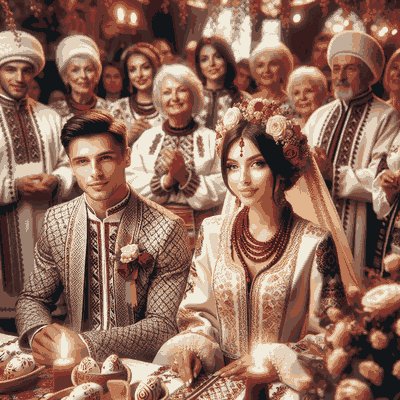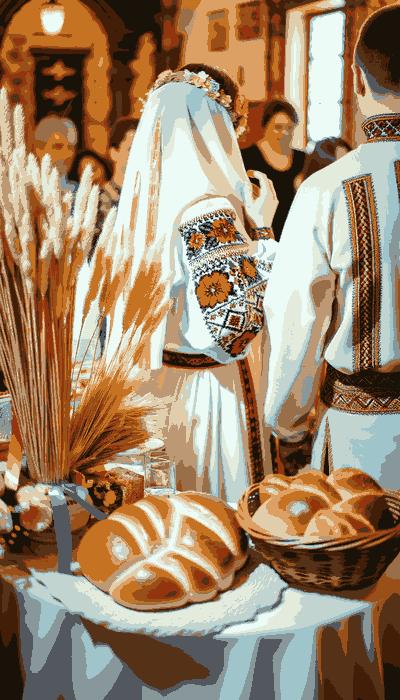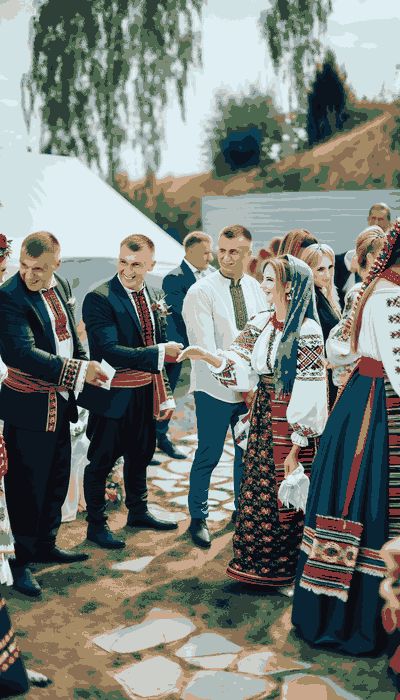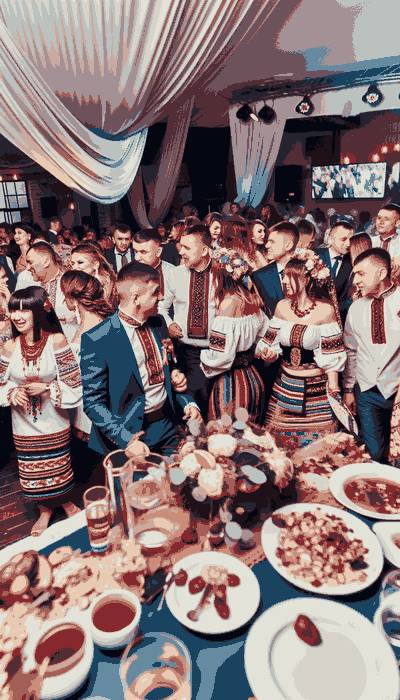Ukraine Wedding Traditions Cultural Wedding Guide 2025
Ukrainian wedding traditions are a comprehensive collection of pre-wedding, ceremonial, and post-wedding customs that typically span 2-3 days and involve 150-300 guests, blending ancient Slavic rituals with Orthodox Christian ceremonies. These traditions encompass matchmaking (svatannyasvah-TAHN-yah), engagement ceremonies (zaruchynyzah-ROO-chin-ee), elaborate wedding breads (korovaikoh-roh-VAI), embroidered ritual cloths (rushnykroosh-NIK), and distinctive regional customs from Ukraine’s diverse ethnic communities.

Overview of Ukrainian Wedding Process & Timeline

Ukrainian weddings follow a structured timeline with specific ceremonies:
- 12-6 months before: Svatannyasvah-TAHN-yahmatchmaking and zaruchynyzah-ROO-chin-eeengagement
- 1-2 weeks before: Divych vechirDEE-vich VEH-cheermaiden’s evening and vinkoplettenyavin-koh-PLET-en-yahwreath-weaving
- Wedding day: Blahoslovennyablah-hoh-sloh-VEN-yahparental blessing, vykup molodoyiVEE-koop moh-loh-DOH-yeebride ransom, religious ceremony, rushnykroosh-NIK ritual
- Reception: Korovaikoh-roh-VAI ceremony, bread and salt greeting, traditional dances, gift-giving
- Post-wedding: Perezvapeh-REZ-vah visits (1-3 days after), moving rituals
Total traditional celebration costs range from $15,000-$50,000 USD depending on guest count and regional variations.
Pre-Wedding Traditions and Ceremonies

What is Svatannya (Ukrainian Matchmaking)?
Svatannyasvah-TAHN-yah is the traditional Ukrainian matchmaking process that historically involved respected village elders (starostystah-ROH-stee) arranging marriages between suitable young people, with the prospective groom visiting the bride’s home accompanied by two matchmakers carrying horilkahoh-RIL-kahUkrainian vodka.
This centuries-old practice included specific protocols where acceptance meant the bride draped a rushnykroosh-NIK around the matchmakers, while rejection involved presenting a pumpkin to the suitor. Modern Ukrainian couples honor this tradition through formal engagement gatherings where the groom presents gifts (typically $500-$2,000 USD worth) to the bride’s parents.
Regional variations of svatannya:
- Western Ukraine: Includes mountain blessings from village elders
- Central Ukraine: Emphasizes elaborate gift exchanges
- Eastern Ukraine: Features extended bread-sharing rituals
Zaruchyny (Ukrainian Engagement Ceremony)
Zaruchynyzah-ROO-chin-ee is the formal Ukrainian engagement ceremony that solidifies the marriage promise through ritual hand-binding with rushnyk, bread and salt exchange, and parental blessings from both families.
Key components of zaruchyny:
- Ritual hand-binding with embroidered rushnyk ($200-$500 value)
- Bread and salt exchange symbolizing shared prosperity
- Parental blessings with special songs and horilka sharing
- Duration: Typically 3-4 hours
- Participants: 20-50 close family members
Modern zaruchyny celebrations maintain the parental blessing element while adapting the formality level to contemporary preferences, with costs ranging from $1,000-$5,000 USD.
Divych Vechir (Ukrainian Maiden’s Evening)
Divych vechirDEE-vich VEH-cheer is the traditional Ukrainian bachelorette celebration that marks the bride’s transition from maidenhood to married life, held the Saturday before the wedding with female relatives and friends gathering to make the wedding wreath and sing ritual songs.
This pre-Christian Slavic tradition involves:
- Wreath-making ceremony with 10-20 female participants
- Unplaiting of maiden’s hair symbolizing life transition
- Traditional songs addressing marriage preparation themes
- Duration: 4-6 hours
- Modern costs: $500-$2,000 USD
Contemporary versions blend traditional elements like wreath-making with modern bachelorette party activities, maintaining the focus on female bonding and emotional preparation for marriage.
Vinkoplettenya (Traditional Wreath-Weaving)
Vinkoplettenyavin-koh-PLET-en-yah is the Ukrainian wedding wreath creation ritual that involves unmarried friends gathering to weave the bride’s vinokvee-NOHK from periwinkle, herbs, and flowers, each chosen for protective and fertility-enhancing properties.
Traditional vinok components and symbolism:
- Periwinkle (barvinokbar-VEE-nohk): Eternal love symbol
- Herbs: Protection and fertility (valued at $50-$100)
- Circular shape: Eternity and life cycles
- Creation time: 3-4 hours
- Participants: 5-7 unmarried women
Modern Ukrainian brides incorporate this tradition through gatherings creating symbolic wreaths or contemporary floral crowns inspired by traditional vinkyveen-KEE, with professional versions costing $150-$500 USD.
Wedding Day Traditions

What is Blahoslovennya (Parental Blessing Ceremony)?
Blahoslovennyablah-hoh-sloh-VEN-yah is the sacred Ukrainian parental blessing ceremony where the couple kneels on a rushnykroosh-NIK before their parents to receive formal approval, prayers, and forgiveness while parents hold icons of Jesus Christ and the Virgin Mary draped with rushnykyroosh-nee-KEE.
This emotional ceremony includes:
- Location: Family homes before church ceremony
- Duration: 30-45 minutes per family
- Key elements: Icons ($200-$1,000), rushnyky ($100-$500), prayers
- Participants: Parents, couple, starosta (elder)
- “Proschanniaproh-SHCHAN-yah”: Dual meaning of forgiving and farewell
Even modern Ukrainian weddings preserve this tradition, though contemporary versions might be incorporated into the wedding ceremony itself rather than performed separately in family homes.
Vykup Molodoyi (Ransoming the Bride)
Vykup molodoyiVEE-koop moh-loh-DOH-yee is the playful Ukrainian tradition where the groom must pass tests, answer riddles, and pay symbolic ransoms to reach his bride, with her friends and family blocking the entrance to her home on the wedding morning.
This entertaining tradition features:
- Duration: 30-60 minutes
- Participants: 10-30 friends and family
- Ransom amounts: $100-$500 USD in small bills
- Common challenges: Riddles about bride, dance performances, strength tests
- Regional variations: Fake bride presentations, negotiation emphasis
Extremely popular in contemporary Ukrainian weddings, modern versions include creative challenges referencing the couple’s relationship, maintaining this tradition even in diaspora communities worldwide.
Ukrainian Rushnyk Ceremony
The rushnyk ceremony is the central Ukrainian wedding ritual where the couple steps onto an embroidered ritual cloth before taking vows, with tradition holding that whoever steps first will have more family authority.
Essential rushnyk ceremony elements:
- Rushnyk cost: $200-$2,000 (heirloom or new)
- Placement: Before altar or officiant
- Symbolism: Life path, ancestral connection
- Embroidery meanings: Protection symbols, good wishes
- Post-wedding: Kept as family heirloom
This tradition remains strong among contemporary Ukrainian couples who appreciate both its symbolic value and visual beauty, often using family rushnyky passed through generations.
Orthodox Crowning Ceremony
The crowning ceremony is the central act in Ukrainian Orthodox and Greek Catholic weddings where ceremonial crowns are placed on the couple’s heads, symbolizing their sovereignty as king and queen of their new family kingdom.
Crowning ceremony specifics:
- Crown types: Metal or floral ($100-$500)
- Duration: 45-90 minutes within service
- Symbolism: Honor, glory, martyrdom, sovereignty
- Modern practice: Held above heads by witnesses (svidkySVEED-kee)
- Religious significance: Byzantine rite connection
This tradition connects modern couples to centuries of Ukrainian religious heritage, remaining central to church weddings.
Ukrainian Wedding Ring Exchange
Ukrainian wedding ring tradition involves wearing bands on the right hand rather than the left, stemming from Orthodox Christian practice where the right hand represents blessing and honor.
Ring tradition details:
- Hand placement: Right hand (traditional)
- Ring costs: $500-$5,000 USD per couple
- Widow practice: Moving ring to left hand
- Symbolism: Eternal unbroken commitment
- Modern adaptations: Some adopt left-hand in Western countries
Many Ukrainian couples maintain right-hand placement as cultural distinction, though diaspora communities sometimes blend traditions.
Reception and Celebration Traditions
What is Korovai (Ukrainian Wedding Bread)?
Korovaikoh-roh-VAI is the elaborate ceremonial Ukrainian wedding bread that serves as the wedding’s central symbol, created through ritual baking by seven married women (korovainytsikoh-roh-VAI-nit-see) with specific songs, holy water, and prayers for the couple’s prosperity.
Korovai tradition encompasses:
- Creation timing: Friday/Saturday before wedding
- Bakers: 7 happily married women only
- Cost: $200-$800 for elaborate versions
- Decorations: Birds (couple), periwinkle (love), wheat (prosperity), pine cones (fertility)
- Display: Between icons at reception
- Distribution: Shared among all guests
Modern Ukrainian weddings feature both korovai and contemporary cake, with the bread’s height traditionally predicting marriage prosperity-the higher it rises, the more successful the union.
Bread and Salt Welcome Ceremony
The bread and salt greeting is the traditional Ukrainian welcome for newlyweds at the reception, where parents present a loaf with salt that the couple shares as their first married act.
This hospitality ritual includes:
- Presenters: Both sets of parents
- Bread type: Decorated loaf ($50-$200)
- Salt placement: Center of bread
- Symbolism: Prosperity (bread), life’s difficulties (salt)
- Duration: 5-10 minutes
Contemporary Ukrainian weddings preserve this tradition as meaningful intergenerational connection and visual reception element, even when incorporating Western elements.
Pokryvala (Bride’s Unveiling Ceremony)
Pokryvalapoh-kree-VAH-lah is the Ukrainian ritual marking the bride’s transition to married status through removal of her maiden’s vinokvee-NOHK and replacement with an ochipokoh-CHEE-pohkmarried woman’s headcovering and namitkanah-MEET-kahheadscarf.
Traditional pokryvala elements:
- Timing: During reception
- Performers: Elderly women
- Original practice: Hair covering requirement
- Regional headdresses: Carpathian elaborate designs, central songs, eastern hair cutting
- Modern cost: $100-$300 for symbolic elements
Contemporary adaptations include symbolic veil removal representing life transition, connecting modern celebrations to ancient customs without full traditional covering.
Darovannya (Ukrainian Gift-Giving Ceremony)
Darovannyadah-roh-VAHN-yah is the formal Ukrainian wedding gift presentation where guests come forward individually or in family groups to present gifts accompanied by personal wishes, blessings, and humorous marriage advice announced by the starostystah-ROH-stee.
Gift-giving tradition features:
- Traditional gifts: Household items, linens, tools
- Modern gifts: Money envelopes ($100-$1,000 per guest)
- Presentation style: Public with announcements
- Reciprocation: Kiss and horilkahoh-RIL-kah toast
- Duration: 1-2 hours depending on guests
Modern Ukrainian receptions maintain ceremonial presentation aspects with formal moments for envelope gifts and personal wishes, distinguishing from private Western gift-giving.
Traditional Ukrainian Wedding Dances
Ukrainian wedding dances (tantsiTAHN-tsee) are ritual celebrations with specific meanings, beginning with the bride dancing with each male guest who pins money to her dress, followed by communal circle dances and energetic group performances.
Essential wedding dances include:
- Hopakhoh-PAHK: Energetic strength showcase
- Kolomyikakoh-loh-MEE-kah: Circle dance with solo center performances
- Arkanar-KAHN: Carpathian men’s brotherhood dance
- HutsulkaHOO-tsool-kah: Western mountain couples dance
- Money dance earnings: $500-$2,000 USD
Contemporary celebrations blend traditional dances with modern music, often hiring professional dance groups ($500-$1,500) while encouraging guest participation regardless of skill level.
Bride Kidnapping Tradition
The Ukrainian bride kidnapping is a playful reception tradition where friends “steal” the bride while the groom is distracted, requiring him to search, perform tasks, or pay ransom for her return.
Kidnapping tradition details:
- Timing: Late reception hours
- Duration: 15-30 minutes
- Ransom types: Songs, dances, money ($50-$200)
- Hiding locations: Within venue or nearby
- Modern twists: Couple-specific challenges
This popular entertainment tradition provides reception breaks and encourages guest participation with creative contemporary adaptations.
Ukrainian Late-Night Wedding Feast
The late-night feast is a traditional second meal served in early morning hours to revive celebrating guests, featuring hearty dishes like kapusnyakkah-POOS-nyahkcabbage soup and varenykyvah-REH-nee-keedumplings.
Late feast components:
- Timing: 1-3 AM
- Traditional dishes: Soups, dumplings, comfort foods
- Cost: $20-$50 per remaining guest
- Symbolism: Enduring community support
- Duration: 1-2 hours
Modern Ukrainian weddings adapt this through midnight buffets or late-night snacks blending traditional comfort foods with contemporary reception fare.
Post-Wedding Traditions
Perezva (Post-Wedding Family Visits)
Perezvapeh-REZ-vah is the Ukrainian tradition of post-wedding visits where newlyweds visit their respective in-laws in the days following the wedding, strengthening bonds between newly united families through feasting and toasts.
Perezva tradition includes:
- Timing: 1-3 days post-wedding
- Duration: Several hours to multiple days
- Participants: Close family members (10-30 people)
- Activities: Feasting, gift exchanges, family bonding
- Modern costs: $500-$2,000 for hosting
Contemporary couples observe simplified versions through post-wedding brunches or family dinners, establishing new family connections in relaxed settings.
Moving the Bride Ceremony
Provodynyproh-VOH-din-ee is the traditional ceremony for moving the bride to her new household, involving ceremonial transportation of her dowry (pridanepree-DAH-neh) and household setup assistance from female relatives.
Moving tradition elements:
- Dowry items: Textiles, household goods ($1,000-$5,000 value)
- Participants: Female relatives
- Protective symbols: Embedded in decorations
- Skill demonstration: Bride’s handmade textiles
- Duration: Full day traditionally
Modern couples adapt through family assistance setting up new homes with traditional Ukrainian textiles or household items as meaningful gifts connecting to historical practice.
Material Culture of Ukrainian Weddings
Traditional Ukrainian Wedding Attire
Traditional Ukrainian wedding attire combines elaborate embroidery with regional styles, featuring the bride’s white sorochkasoh-ROHCH-kahembroidered shirt, decorated plakhtaPLAHKH-tah or skirt, vinokvee-NOHK with ribbons, and multiple protective necklaces (namystonah-MEES-toh).
Traditional attire components and costs:
- Bride’s ensemble: $2,000-$10,000 for authentic pieces
- Embroidered sorochka: $500-$2,000
- Vinok with ribbons: $200-$800
- Namysto (necklaces): $300-$1,500
- Groom’s outfit: $1,000-$3,000
Regional style variations:
- Carpathian: Geometric designs, wool elements
- Central Ukrainian: Floral patterns in red and black
- Eastern: Silk elements, urban influences
- Northern: White-on-white embroidery
Contemporary Ukrainian brides incorporate traditional elements through embroidered details, modern vinok interpretations, or changing into traditional outfits for reception portions.
Rushnyk (Ceremonial Towels) in Detail
Rushnykyroosh-nee-KEE are intricately embroidered ritual cloths serving multiple wedding functions including ceremony standing cloth, hand-binding, korovaikoh-roh-VAI wrapping, icon draping, and honored guest gifts.
Rushnykroosh-NIK types and values:
- Wedding ceremony rushnyk: $500-$2,000
- Engagement binding rushnyk: $200-$500
- Korovai rushnyk: $300-$800
- Icon rushnyky: $200-$500 each
- Guest gift rushnyky: $100-$300 each
Embroidery symbolism includes trees of life (family continuity), birds (couple), geometric patterns (protection), flowers (beauty/fertility), and berries (abundance). Contemporary couples use family heirlooms or commission new traditional-style pieces displayed post-wedding as home decoration.
The Ukrainian Wedding Vinok
The vinok is the traditional Ukrainian bridal wreath made from periwinkle, herbs, and flowers with long colorful ribbons, symbolizing purity, eternity, and the bride’s transition to married status.
Vinok construction details:
- Materials cost: $100-$500
- Ribbon colors: Green (youth), pink (beauty), orange (strength)
- Herb selection: Protection and fertility properties
- Regional variations: Carpathian metallic elements, central ribbons, eastern beadwork
- Creation time: 3-4 hours
Modern Ukrainian brides adapt through simplified vinkyveen-KEE or flower crowns inspired by tradition, sometimes wearing traditional style for ceremony and contemporary headpiece for reception.
Modern Ukrainian Wedding Trends 2025
Ukrainian wedding traditions in 2025 reflect evolving practices:
- Fusion celebrations blend traditions with contemporary elements (70% of couples)
- Virtual participation connects diaspora families for korovaikoh-roh-VAI making ($200-$500 streaming setup)
- Destination adaptations at Las Vegas chapels offer Ukrainian packages ($5,000-$15,000)
- Sustainable vinkyveen-KEE use local flowers reducing costs 30-50%
- Regional revival researches specific family heritage customs
- Compressed timelines fit multi-day traditions into single celebrations
- Gender-neutral adaptations reimagine traditional roles
- Heritage tourism combines Ukraine ceremonies with luxury experiences ($10,000-$30,000)
Contemporary Ukrainian couples successfully blend ancestral traditions with modern preferences, creating meaningful celebrations honoring heritage while expressing individual style-whether in Ukrainian villages, North American churches, or Las Vegas wedding chapels.
Frequently Asked Questions
How much do Ukrainian weddings typically cost?
The honest answer might make you reach for that horilka(vodka). Traditional Ukrainian weddings run $15,000-$50,000 USD, with the average hovering around $25,000-$30,000 USD for 150-200 guests. The wide range depends on whether you're going full traditional with handmade rushnyky(ritual towels), professional dancers, and a three-day celebration, or adapting traditions to modern budgets. Smart couples focus spending on meaningful elements—maybe splurge on an authentic korovai(wedding bread) but skip the 20-piece band. Remember, Ukrainian guests typically give generous monetary gifts ($200-$1,000 USD per family), which helps offset costs.
How much does a traditional Ukrainian wedding cost?
A traditional Ukrainian wedding typically costs between $15,000-$50,000, varying by region and scale. This includes ceremonies, attire, catering, and traditional elements like korovai and rushnyky.
Do modern Ukrainian couples still do all these traditions?
Great question—and the answer varies wildly. Most couples (about 70%) blend traditions with contemporary preferences, creating "greatest hits" versions of Ukrainian weddings. Core traditions like the rushnyk(ritual towel) ceremony, korovai, and parental blessings remain popular because they're meaningful and photographable. Meanwhile, traditions like pokryvala(head covering ceremony) get modern makeovers, and some skip vykup(bride ransoming) if they find it outdated. The key is choosing what resonates with your family while keeping guests engaged—nobody needs a 6-hour ceremony just for tradition's sake.
What is the significance of korovai in Ukrainian weddings?
Korovai is a ceremonial bread that symbolizes prosperity and fertility. This intricately decorated wedding bread is central to the reception and is shared among guests as a blessing.
What should non-Ukrainian guests know before attending?
First, eat a substantial breakfast—you're in for a marathon, not a sprint. Ukrainian weddings typically last 8-12 hours minimum, with some extending into multi-day affairs. Bring cash in small bills for various traditions like the money dance and potential "ransoms." Don't be alarmed by bride kidnapping—it's playful tradition, not an actual crime. Be prepared to dance whether you know the steps or not (you'll learn by round three of the kolomyika). Most importantly, pace yourself with the horilka toasts—there will be MANY, and each requires participation. When in doubt, follow the babusyas' lead; they've survived hundreds of these celebrations.
How long do Ukrainian wedding celebrations last?
Traditional Ukrainian weddings typically span 2-3 days, including pre-wedding ceremonies, the main wedding day, and post-wedding celebrations called perezva.
Why do Ukrainians wear wedding rings on their right hand?
This Orthodox Christian tradition designates the right hand as the hand of blessing and honor—quite literally the "right" hand of God. When you make the sign of the cross, you use your right hand, making it the appropriate place for sacred symbols like wedding rings. The practice dates back to Byzantine times and remains standard across Orthodox cultures. Interestingly, if a spouse becomes widowed, they often move the ring to their left hand to indicate their changed status. Some diaspora Ukrainians adapt by wearing engagement rings on the left and wedding bands on the right, creating a bicultural compromise.
What is svatannya in Ukrainian wedding tradition?
Svatannya is the traditional matchmaking ceremony where the groom's family formally asks for the bride's hand in marriage, though modern couples often adapt it as an engagement celebration.
What's the deal with the bread at Ukrainian weddings?
Bread isn't just carbs at Ukrainian weddings—it's practically a cast member. The star is korovai, an elaborate ceremonial bread that requires seven happily married women to bake while singing specific songs. This architectural masterpiece ($200-$800 USD) features dough decorations telling the couple's story. Then there's the bread and salt greeting, where parents offer a shared loaf representing prosperity (bread) and life's hardships (salt). Various other breads appear throughout celebrations because Ukrainians believe you can't properly celebrate without enough carbohydrates to fuel three days of dancing. Modern couples often display korovai alongside a Western wedding cake—why choose when you can have both?
What is the rushnyk ceremony?
The rushnyk ceremony involves couples stepping onto an embroidered ritual cloth before exchanging vows. The first to step on the rushnyk is said to be the household leader.
How long do Ukrainian wedding celebrations really last?
Buckle up: traditional Ukrainian weddings are endurance events. The full traditional timeline spans 3-7 days, though modern couples often compress this into an intense 1-2 day celebration. It starts with divych vechir(maiden's evening) the night before, then wedding day begins with morning blessings, afternoon ceremony, evening reception lasting until dawn, and extends through perezva(family visits) the following days. Even "simplified" modern versions rarely wrap before 2 AM. One couple described it perfectly: "American weddings are sprints—four hours and done. Ukrainian weddings are marathons where somehow everyone's still dancing at hour twelve."
What should guests wear to a Ukrainian wedding?
Guests should dress formally, with many incorporating vyshyvanka (traditional embroidered clothing). Avoid wearing all black or all white, as these are considered inappropriate.
Can you have a Ukrainian wedding if only one partner is Ukrainian?
Absolutely, and these fusion weddings often create the most memorable celebrations. The key is education and respect—help your non-Ukrainian partner understand tradition meanings rather than just going through motions. Many mixed couples cherry-pick the most meaningful or fun traditions. Maybe you'll do the rushnyk ceremony but skip the extensive kidnapping negotiations. Perhaps you'll serve both korovai and your partner's cultural dishes. The Ukrainian family usually LOVES introducing someone new to their traditions—just be prepared for enthusiastic over-explanation of every custom and multiple "teaching moments" on the dance floor.
What is the significance of the Ukrainian vinok?
The vinok is a traditional bridal wreath made of flowers and herbs, symbolizing purity and fertility. It's worn until the pokryvala ceremony when the bride becomes a married woman.
What happens if you mess up a tradition?
Relax—Ukrainian weddings have survived wars, famines, and Soviet suppression; they can handle your mistakes. Most "rules" have flexibility built in. Stepped off the rushnyk during vows? Your marriage isn't doomed (though someone's babusya might insist on extra blessings). Forgot the ransom money for vykup? IOU's and Venmo have entered the tradition. Can't find seven happily married women to bake korovai? Six will do, or buy from a Ukrainian bakery. The spirit matters more than perfect execution. As one elder noted: "My grandmother got married during harvest season with a rushed one-day wedding. Still lasted 64 years."
What happens during the vykup molodoyi (bride ransom)?
During vykup molodoyi, the groom must pass tests and pay symbolic ransoms to the bride's family and friends before being allowed to see his bride on the wedding day.
Is the bride kidnapping thing actually fun or just stressful?
When done right, bride kidnapping adds hilarious energy to receptions. The key is planning—the bride should know it's coming (even if not exactly when) and have veto power over hiding spots. Good kidnappings last 15-30 minutes max, involve creative ransoms (embarrassing stories, silly dances, moderate cash), and include the whole wedding party. Bad kidnappings drag on, actually upset the bride, or happen when she needs a bathroom break. Modern twists include kidnapping the groom instead, stealing both newlyweds together, or "kidnapping" something symbolic like the wedding shoes. Pro tip: assign a trusted friend as kidnapping coordinator to keep things fun, not frantic.
Are Ukrainian weddings religious ceremonies?
Most Ukrainian weddings include an Orthodox Christian ceremony called the Crowning Ceremony, though couples may also incorporate civil ceremonies and traditional Slavic rituals.
What gifts are appropriate for Ukrainian weddings?
Cash reigns supreme at Ukrainian weddings, presented in decorative envelopes during the public darovannya(gift-giving ceremony). Standard amounts: close family $500-$1,000 USD, friends $200-$500 USD, acquaintances $100-$200 USD. Yes, these are higher than typical Western wedding gifts, but Ukrainian hospitality comes with reciprocal generosity. If you prefer physical gifts, high-quality household items work—think crystal, quality linens, or silver. Avoid knives (they "cut" relationships) or handkerchiefs (for tears). The public presentation means your gift gets announced, so that $50 gift card might feel awkward when the previous family just gave $500 USD.
What gifts are appropriate for a Ukrainian wedding?
Money is the most common gift, traditionally presented during the darovannya ceremony. Practical household items and family heirlooms are also appropriate gifts.
Do you need to speak Ukrainian to participate?
Not at all, though learning a few key phrases scores major points with elder relatives. Most traditions are visual—you can follow along with dancing, toasting, and ceremonies without understanding every word. Key phrases to know: "Budmo!" (cheers), "Mnohaya lita!" (many years/congratulations), and "Hirko!" (bitter—shouted when guests want the couple to kiss). The vodka toasts might get increasingly poetic/incomprehensible as the night progresses, but raising your glass and smiling translates universally. Many Ukrainian weddings feature bilingual MCs who translate key moments.
How do you survive a Ukrainian wedding as a guest?
Veterans share these survival strategies: Eat the provided breakfast/lunch—you'll need stamina. Bring backup shoes (especially for dancing). Carry small bills for traditions. Stay hydrated between horilka toasts. Take dance-floor breaks during the marathon kolomyika circles. Don't try to match the babusyas drink-for-drink—they've trained for decades. Embrace looking foolish during unfamiliar dances; enthusiasm beats accuracy. Pack antacids for the 3 AM feast. Most importantly, surrender to the experience—Ukrainian weddings aren't spectator sports. The more you participate, the more magical they become. As one convert noted: "I went as a skeptical plus-one and left planning how to convince my fiancé we needed a Ukrainian wedding too."